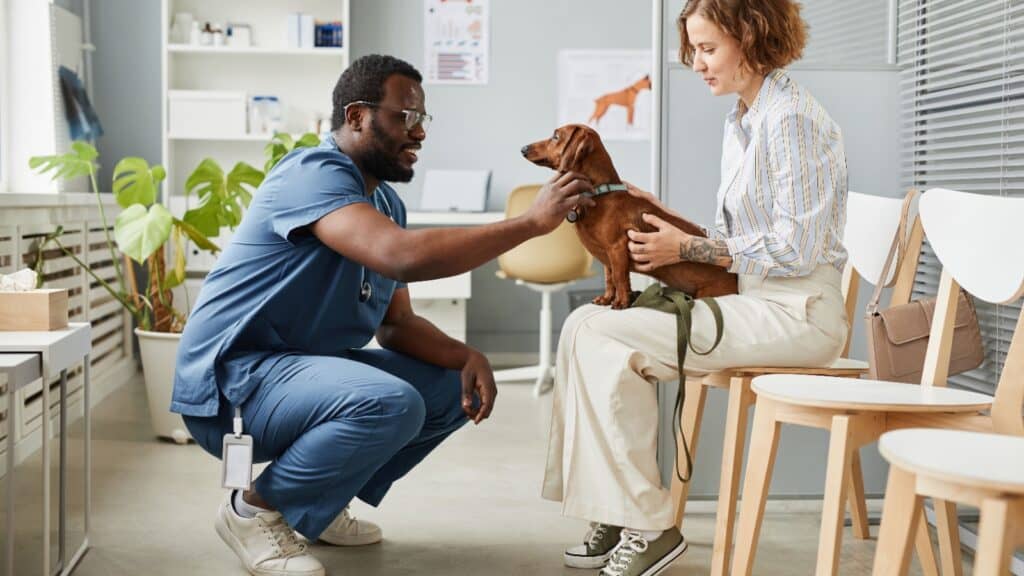What Every Dog Owner Must Have in Their First Aid Kit (And How To Tell When It’s Truly An Emergency)
As responsible dog owners, it’s crucial to be prepared for any health emergencies that might arise. Just like humans, dogs can experience accidents, injuries, and sudden illnesses that require immediate attention. Having a well-equipped first aid kit, specifically for your dog, can be a lifesaver in such situations. This guide will walk you through the essential items to include in your dog first aid kit, their uses, and critical signs that indicate when it’s time to head to the vet. By being prepared and knowledgeable, you can ensure your dog’s safety and well-being in any emergency.
Choose a Good Container

A sturdy, waterproof container, such as a fishing tackle-type box, or a box built for the task, will keep the items clean and safe from damage. You can also have a smaller one prepared for travel.
Label Everything Clearly

Label everything clearly if it is not obvious, such as if you decant pills. We love our label-maker!
Paperwork!

Start by packing your dog’s veterinary records and important phone numbers, such as:
- Dates of last vaccinations and any other pertinent information if your dog has illnesses or prior injuries.
- Phone numbers of primary veterinarian.
- Phone number of poison control. ASPCA Animal Poison Control Center Phone Number is (888) 426-4435
- Phone number for nearest emergency veterinary hospital.
- Names and doses of medications taken regularly by each dog.
- Owners’ names, addresses, and phone numbers. This information is helpful to the owner at a potentially traumatic time, but it is also helpful if the owner is incapacitated or other people less familiar with the dog(s) need to find or use the kit.
Essential Items for a Dog First Aid Kit

Let’s look at basic supplies and medications, and their proper use.
Basic Supplies for a Canine First Aid Kit

- Adhesive Tape: To secure bandages.
- Sterile Gauze Pads and Rolls: For wound dressing. Used to dress and secure wounds, protecting them from dirt and bacteria.
- Non-Stick Bandages: Such as Eco-Fused Self-Adhering Bandage
- Cotton Balls and Swabs: For cleaning wounds and applying medications.
- Bandage Scissors: For cutting bandages and tape.
- Tweezers: For removing splinters or ticks.
- Digital Thermometer: For checking your dog’s temperature rectally. Helps monitor your dog’s body temperature to detect fever or hypothermia.
- Disposable Gloves: To maintain hygiene while treating injuries.
- Syringes: To flush wounds or to give oral medications. Try to find ones that are individually sealed for increased sanitation.
- Saline Solution: For cleaning wounds and flushing out eyes.
- Antiseptic Wipes/Solution: For disinfecting wounds.
- Latex gloves: To protect your hands.
- Canned Dog Food: Can help reduce the effects of poisoning. If poisoning is suspected, contact the poison control center before administering anything to your dog by mouth. Treatment varies depending on the type of poison. Make sure the can opens by a pull-tab and doesn’t require an opener.
Medications for a Canine First Aid Kit

Please use medications as directed by a veterinarian. The ones we would use without veterinary assistance are antibiotic ointment for minor scrapes and cuts, and styptic powder for bleeding, such as with a torn nail. Always follow up with your vet.
- Hydrogen Peroxide: Antiseptic and can be used to induce vomiting (only under veterinarian advice).
- Antibiotic Ointment: For minor cuts and scrapes, such as Vetericyn Plus Antimicrobial Hydrogel Healing Aid Spray.
- Antihistamine: For allergic reactions (dose based on veterinarian’s advice).
- Activated Charcoal: To absorb toxins in case of poisoning (use under veterinarian guidance).
- Milk of Magnesia: Can also be used to absorb and counteract poisons, (use under veterinarian guidance).
- Styptic Powder: To stop minor bleeding.
Additional Tools and Instruments for a Canine First Aid Kit

Here are more tools and instruments to consider having on hand:
- Muzzle: To prevent biting during treatment.
- Extra Leash and Collar: For your dogs, or when finding stray dogs
- Tick Remover: Specialized tool for safely removing ticks.
- Magnifying Glass: For inspecting small wounds or foreign objects.
- Flashlight: For better visibility in low light conditions. We like headlight styles to keep hands free.
- Towels: An assortment is good; we like absorbent and also microfiber.
Comfort and Safety Items for a Canine First Aid Kit

If you include only one item from this list, make it bottled water.
- Collapsible Water Bowl and Bottled Water: To keep your dog hydrated.
- Emergency Blanket: To keep your dog warm if they are in shock.
- Rescue Harness: For carrying or securing your dog in emergencies.
Consider Taking a Canine CPR Class

Please consider taking a canine CPR class.
CPR involves chest compressions, with or without artificial respiration, and should be administered only when the dog’s heartbeat is undetectable, and the dog is not breathing. This condition may arise due to trauma, choking, or illness. It’s crucial to understand that performing CPR on a dog is risky and can cause severe complications or even fatal damage if done on a healthy animal.
CPR should be a last resort, used only when absolutely necessary. Ideally, have someone contact your veterinarian for guidance while you perform CPR on the way to the clinic. Ensure the dog’s airway is clear of any obstructions before starting CPR. The method of performing CPR can vary depending on the size and breed of the dog.
And Take A Pet Safety Course

Did you know that the Red Cross has an online Cat & Dog Safety Training Course? It is a 35-minute training course that teaches and offers:
- How to check your pet’s vital signs, how to conduct preventative care for your pets, and how to recognize and provide first aid for the most severe emergencies your pet may experience.
- Red Cross digital certification provided upon completion – access anytime, anywhere!
- Desktop and tablet compatibility providing flexibility to access how, when, and where you want to take the course.
- Log-in anytime to review course material.
- Content developed by the American Red Cross team of scientific and medical experts.
The Red Cross also has a Pet First Aid App for your smartphone.
Extra Considerations

Some dog owners travel extensively with their canine companions. We show our mini bull terrier, Nora, for instance, all over the country and into Canada. Our scent work instructor has dogs that work at FEMA disasters. There are dogs that compete in extreme sports, like the Iditarod, or that might be traveling far away from home for an extended time.
Speak to your vet about any medications they suggest you have on hand and that they would be willing to give you. Certain pain medications (as about Rimadyl) and emetics might be useful, with proper training for use. Having a prescription for antibiotics might be prudent as well (we keep some on hand because we live in a tick infected area, for instance).
What To Never Do

Never give human medication to a dog without veterinarian advice. Human pain or anti-inflammatory medications such as Ibuprofen (Advil; Motrin) or Naproxen are toxic to pets and could cause greater problems and even lead to death.
When to Seek Veterinary Care

Knowing when to administer first aid and when to seek professional help is crucial. Here are the top 10 instances:
- Serious Wounds: Deep cuts, puncture wounds, or severe bleeding should be treated by a veterinarian immediately.
- Persistent Vomiting or Diarrhea: More than 24 hours of vomiting or diarrhea, or if blood is present, requires veterinary attention.
- Breathing Difficulties: Any signs of difficulty breathing, wheezing, or choking are emergencies.
- Unresponsive or Lethargic: If your dog is unresponsive, excessively lethargic, or collapses, seek immediate veterinary care.
- Ingesting Toxic Substances: If you suspect your dog has ingested a toxic substance, contact a vet or poison control center immediately.
- Eye Injuries: Any injuries to the eyes or sudden changes in vision need professional evaluation.
- Broken Bones: If you suspect a fracture or broken bone, immobilize your dog and go to the vet.
- Severe Allergic Reactions: Swelling of the face, hives, or difficulty breathing after a sting or allergic reaction needs urgent care.
- Seizures: If your dog has a seizure, keep them safe and seek veterinary help immediately.
- Anytime you are unsure or uncomfortable making the call on your dog’s status. Always better to be safe than sorry.
Update As Needed

Check your kit yearly and replace items that might have expired. This is an often overlooked step.
You Can Also Buy Premade Kits

Check out the premade kits that are available. Easy to grab!
The Takeaway

A well-stocked dog first aid kit and knowing how to use it can make a significant difference in an emergency. Always keep your kit accessible and regularly check its contents for expiration. While first aid can address minor injuries and stabilize your dog in emergencies, professional veterinary care is irreplaceable for serious conditions. By being prepared, you can ensure your dog’s health and safety in various situations.
Shop Our Recommendations

If you are viewing this on MSN Start please click here to see our recommended first aid products.
How To Protect Your Dog From Heat Stroke This Summer And What NOT To Do!

Summer is here and it’s essential to prioritize your dog’s safety and well-being by taking proactive steps to prevent overheating. Dogs are more susceptible to heat-related illnesses due to their inability to sweat like humans, making it crucial for pet owners to be aware of the signs, prevention methods, and emergency procedures to ensure their dog stays cool and healthy. In the most serious cases of canine dehydration, severe fluid shortage can lead to the failure of the kidneys and other organs.
In addition, we keep seeing posts, on Facebook in particular, that have incorrect, and even dangerous information. All of the information here is evidence-based.
READ: How To Protect Your Dog From Heat Stroke This Summer And What NOT To Do!
How Many Of These Foods Did You Know Could Kill Your Dog?

Our canine companions bring immense joy into our lives, and it’s our duty to ensure their well-being. However, certain everyday foods found in our homes can pose serious risks to their health. Here’s a look at foods that should never be fed to dogs or left within their reach.
To be prepared, have contact details of your local veterinarian, the nearest emergency clinic, and the ASPCA Animal Poison Control Center (888-426-4435) at hand. READ: How Many Of These Foods Did You Know Could Kill Your Dog?
Understanding The Surge In Veterinary Costs: Is It Becoming Too Expensive To Have A Pet?

If you own a pet, we bet you have noticed that veterinary care costs are escalating, leaving many of us with sticker shock and struggling to secure timely appointments. There are reasons for this burgeoning phenomenon; we unveil the many factors steering this surge. Read: Understanding The Surge In Veterinary Costs: Is It Becoming Too Expensive To Have A Pet?
Join Us

Join us on this empowering journey as we explore, celebrate, and elevate “her story.” The Queen Zone is not just a platform; it’s a community where women from all walks of life can come together, share their experiences, and inspire one another. Welcome to a space where the female experience takes center stage. Sign up for our newsletter so you don’t miss a thing, Queen!
Last update on 2024-09-07 / Affiliate links / Images from Amazon Product Advertising API
















